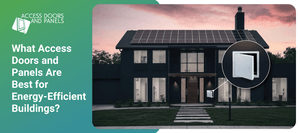What Access Doors and Panels Are Best for Energy-Efficient Buildings?
Posted by Access Doors and Panels on 3rd Apr 2025
Energy efficiency is vital today due to environmental concerns, rising energy costs, and stricter regulations. Sustainability drives modern practices, emphasizing the optimization of the building envelope, which controls heat exchange.
A well-designed envelope minimizes air leakage, maximizes insulation, and manages solar gain, reducing reliance on HVAC systems and leading to cost savings. While architects focus on high-performance windows and insulation, access doors and panels are often overlooked energy efficienct components.
Inadequate access solutions can compromise the envelope's integrity, leading to air infiltration and increased HVAC demands. Choosing the right doors and panels is crucial, considering insulation, airtightness, and durability. High-performance access solutions enhance energy efficiency and support a sustainable built environment.
Understanding Energy Loss Through Access Points
Even a well-insulated home can suffer energy loss through gaps around access doors and panels. These components, though small, can create significant pathways for air to escape or enter, affecting energy efficiency.
- Conduction: Heat transfer occurs when two objects touch. Thin materials, like metal access doors, can easily conduct heat, leading to energy loss.
- Convection: Air leaks around poorly sealed access points allow warm or cool air to escape, forcing HVAC systems to work harder and increasing energy consumption.
- Radiation: Although less impactful, heat transfer through electromagnetic waves can also contribute to energy loss.
The consequences of inadequate access solutions include:
- Increased Energy Consumption: Poorly designed access points make HVAC systems less efficient.
- Higher Utility Bills: More energy use translates to higher costs for occupants.
- Reduced Comfort: Air leaks can create temperature fluctuations, affecting comfort and productivity.
- Condensation and Mold Growth: Moist indoor air can condense on cold surfaces, leading to mold and health risks.
By choosing access doors and panels that minimize energy loss, architects and contractors can improve building performance.
Key Characteristics of Energy-Efficient Access Solutions
To minimize energy loss, access doors and panels should feature:
High-Performance Insulation
Effective insulation is crucial for preventing heat transfer. Materials like mineral wool, polyurethane, and expanded polystyrene are commonly used. The R-value measures thermal resistance; a higher value shows better insulation. Full coverage of the insulation is necessary to eliminate gaps.
Insulated access panels, such as the BA-ALI aluminum insulated access panel, feature high-density insulation materials and keep a consistent thickness to ensure best performance.
Airtight Seals
Air leaks can undermine energy efficiency. Durable gaskets are essential for an airtight seal. Compression gaskets and magnetic seals provide effective solutions but need careful installation for optimal performance.
Durable Construction
Access doors and panels are designed to endure frequent use and various conditions. Stainless steel and aluminum are preferred materials due to their strength and resistance to corrosion. Additionally, galvannealed steel is commonly used for general-purpose access doors.
Accessibility and Ease of Use
Designs should help easy access for maintenance. Features like smooth hinges and easy-grip handles enhance usability.
Incorporating these characteristics helps architects and contractors select access solutions that improve energy efficiency and building safety.
Choosing the Right Access Doors and Panels
Selecting the right access doors and panels for a project requires careful evaluation of several factors to enhance energy efficiency and meet specific needs.
Key Factors to Consider
- Building Codes and Energy Standards: Ensure compliance with regulations, specifying minimum access solutions' performances.
- Project Requirements: Consider fire ratings, size, and location of access points. Larger panels need effective insulation, while frequent use demands durability and ease of operation.
- Environmental Conditions: In extreme temperatures or high humidity, choose materials that resist moisture and prevent heat transfer to keep safety and functionality.
- Aesthetics: Access solutions should blend with the building's design while providing energy efficiency.
- Product Certifications: Select solutions that meet industry standards, such as those from ASTM and UL, and consider certifications like ENERGY STAR and LEED for energy efficiency.
- Vendor Partnerships: Work with reputable vendors for technical expertise and support throughout the design and installation processes. Access Doors and Panels offers a wealth of knowledge and resources to help you make informed project decisions. Visit our blog for more insights and best practices on selecting and installing energy-efficient access solutions.
- Cost-Benefit Analysis: Investing in high-quality, energy-efficient solutions may have a higher initial cost but leads to long-term savings on energy bills and increased building value.
By factoring in these elements, stakeholders can make informed choices that ensure best energy performance and project success.
Installation Best Practices
Effective installation is crucial for the optimal performance of access doors and panels. Even high-quality insulated panels won't function properly if not installed correctly.
Key Installation Procedures
- Sealing: Ensure all gaps around the access door or panel are completely sealed using high-quality sealants and tapes. Proper adhesion to the panel frame and surrounding structure is vital to prevent air infiltration.
- Alignment: Correct alignment is essential for smooth operation and seal integrity. Misaligned panels can create gaps, leading to air leakage and decreased energy efficiency.
- Finishing: Superbly finish the area around the door or panel for a clean appearance. Ensure any trim or molding is correctly installed and sealed to prevent air leakage and enhance visual appeal.
Skilled Labor Is Essential
Engaging experienced installers who understand best practices is crucial for effective installation.
By following these best practices, architects, designers, and contractors can ensure that access doors and panels function optimally, maximizing energy efficiency and project success.
Conclusion
Attention to access doors and panels is essential for sustainable and energy-efficient buildings. Selecting high-quality, energy-efficient solutions reduces energy consumption by minimizing air infiltration and heat transfer, lessening reliance on HVAC systems and lowering operational costs.
Incorporating energy-efficient access doors and panels is not just a best practice; it is vital for achieving sustainable, high-performance buildings. Architects, designers, and contractors can significantly affect a more energy-conscious and environmentally responsible future by focusing on these critical components.

